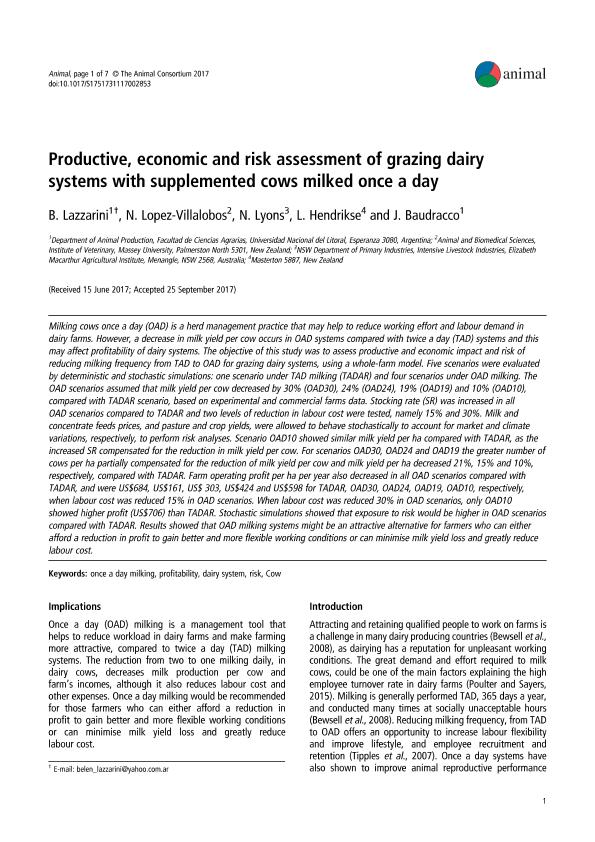Artículo
Productive, economic and risk assessment of grazing dairy systems with supplemented cows milked once a day
Fecha de publicación:
05/2018
Editorial:
Cambridge University Press
Revista:
Animal
ISSN:
1751-7311
Idioma:
Inglés
Tipo de recurso:
Artículo publicado
Clasificación temática:
Resumen
Milking cows once a day (OAD) is a herd management practice that may help to reduce working effort and labour demand in dairy farms. However, a decrease in milk yield per cow occurs in OAD systems compared with twice a day (TAD) systems and this may affect profitability of dairy systems. The objective of this study was to assess productive and economic impact and risk of reducing milking frequency from TAD to OAD for grazing dairy systems, using a whole-farm model. Five scenarios were evaluated by deterministic and stochastic simulations: one scenario under TAD milking (TADAR) and four scenarios under OAD milking. The OAD scenarios assumed that milk yield per cow decreased by 30% (OAD30), 24% (OAD24), 19% (OAD19) and 10% (OAD10), compared with TADAR scenario, based on experimental and commercial farms data. Stocking rate (SR) was increased in all OAD scenarios compared to TADAR and two levels of reduction in labour cost were tested, namely 15% and 30%. Milk and concentrate feeds prices, and pasture and crop yields, were allowed to behave stochastically to account for market and climate variations, respectively, to perform risk analyses. Scenario OAD10 showed similar milk yield per ha compared with TADAR, as the increased SR compensated for the reduction in milk yield per cow. For scenarios OAD30, OAD24 and OAD19 the greater number of cows per ha partially compensated for the reduction of milk yield per cow and milk yield per ha decreased 21%, 15% and 10%, respectively, compared with TADAR. Farm operating profit per ha per year also decreased in all OAD scenarios compared with TADAR, and were US$684, US$161, US$ 303, US$424 and US$598 for TADAR, OAD30, OAD24, OAD19, OAD10, respectively, when labour cost was reduced 15% in OAD scenarios. When labour cost was reduced 30% in OAD scenarios, only OAD10 showed higher profit (US$706) than TADAR. Stochastic simulations showed that exposure to risk would be higher in OAD scenarios compared with TADAR. Results showed that OAD milking systems might be an attractive alternative for farmers who can either afford a reduction in profit to gain better and more flexible working conditions or can minimise milk yield loss and greatly reduce labour cost.
Palabras clave:
Cow
,
Dairy System
,
Once a Day Milking
,
Profitability
,
Risk
Archivos asociados
Licencia
Identificadores
Colecciones
Articulos(CCT - SANTA FE)
Articulos de CTRO.CIENTIFICO TECNOL.CONICET - SANTA FE
Articulos de CTRO.CIENTIFICO TECNOL.CONICET - SANTA FE
Citación
Lazzarini, Maria Belen; Lopez Villalobos, Nicolas; Lyons, N.; Hendrikse, L.; Baudracco, Javier; Productive, economic and risk assessment of grazing dairy systems with supplemented cows milked once a day; Cambridge University Press; Animal; 12; 5; 5-2018; 1077-1083
Compartir
Altmétricas




